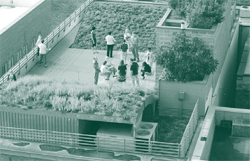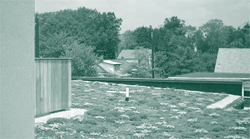October 2008
In this Issue
Healthier Homes, Healthier Children
Local Transitional Housing Effort Wins Award
A New Formula for Greening Neighborhoods
In the Garden... On the Roof!
In the next issue of ResearchWorks
In the Garden... On the Roof!
Garden roofs are gaining visibility as a cost-effective, energy-efficient, and environmentally friendly feature in affordable residential construction. The two common types of garden roofs — extensive and intensive — both consist of four basic components: a water barrier, a drainage and filtering system, the growing medium, and vegetation. Extensive gardens are shallow (typically between 1 and 6 inches deep) and require little maintenance. These garden roofs are usually planted with local, drought-resistant moss, sedum, and herbs. By contrast, intensive roof gardens are typically 8 to 24 inches deep. The grasses, flowers, trees, and shrubs planted in these gardens need more maintenance than the vegetation in extensive gardens, and may require irrigation and root retention systems.
These alternative rooftops conserve energy, water, and materials. According to the U.S. Environmental Protection Agency (EPA), on a hot summer day, a traditional rooftop might be 90°F warmer than the ambient air, whereas a vegetated rooftop surface can be cooler than the surrounding air temperature. Because vegetated rooftops absorb less heat, the "heat island" effect caused by buildings that retain the sun's warmth is reduced, particularly in cities. The cooling effect of the vegetation also means that less heat is transferred to the building interior. In winter, the vegetation provides insulation that improves a building's heat retention. The impact on energy bills varies with local conditions, roof type, and other green building features. In Silver Spring, Maryland, the intensive roof garden atop Eastern Village Cohousing contributes to an overall estimated energy savings of 25 percent.1 This mixed-income condominium complex reduces water consumption by collecting water runoff from the roof in rain barrels and using it to irrigate plantings at ground level.

As to conserving water, the EPA compares a garden roof to a sponge; the vegetation simply absorbs and uses rainwater. The Michigan State University (MSU) green roof research program finds that the plants absorb between 60 to 100 percent of storm water, thus preventing excessive runoff, averting pollution of streams and lakes, and reducing demand placed on storm water drainage and water treatment systems.2
It should be noted that the initial costs of garden roofs are relatively high. The city of Portland, Oregon estimates that a garden roof installation there costs from $10 to $25 per square foot, compared with $3 to $9 per square foot for a conventional roof. Unless built to specification (with a garden roof part of the original design), many buildings must have their roofs retrofitted to support this feature, thus adding to upfront costs.3 This was the case with Artists' Housing, an affordable complex in Mount Rainier, Maryland. Its extensive roof garden, the first in Prince George's County to be installed over an existing wood frame, required additional joists to support its weight.
Portland's Hamilton West Apartments, available to those with incomes at 40 – 60 percent of the area median income, has a garden roof that cost $10.50 per square foot. Funded by the city, the Portland Housing Authority, and the Portland Development Commission, this garden roof is part of a citywide attempt to resolve a storm water runoff problem that is contaminating rivers and streams. Like all garden roofs, the one at Hamilton West required a larger initial investment for material and labor, but it will last two to three times longer than a conventional roof, because vegetative roofs have natural protection from the ultraviolet radiation and extreme temperature fluctuations that cause roofing materials to deteriorate.4 According to the EPA, the upfront costs of garden roofs can eventually be recovered through energy savings and reduced expenses for repairs and replacement, making the price over time comparable to that of a conventional roof.
Another benefit of garden roofs is the simple pleasure of being outdoors. Eastern Village Cohousing's rooftop has a gazebo and patio, walkways of concrete pavers, a play area, and trellises with vines, creating the feel of an outdoor haven in an urban area. The affordable Gold Dust Apartments in Missoula, Montana combine a garden roof with vegetable gardening boxes. Gold Dust residents without gardening experience can consult with a gardening intern and sign up for organic gardening workshops. The Cascade Senior Apartments in Seattle, Washington is a new development financed with HUD Section 202 funds and 9 percent Low Income Housing Tax Credits. Cascade’s low-income senior residents will be able to enjoy the view while growing vegetables in planters incorporated into their green roof design.5

Overall, communities that recognize the benefits of roof gardens are multiplying. Green Roofs for Healthy Cities, an industry association, reported that in North America, total garden roof square footage grew 30 percent overall in 2007.6 Vegetative roofs are also providing benefits that improve quality of life, such as absorbing sound, reducing dust and smog pollution, providing a natural habitat for butterflies and birds, and beautifying cities. These advantages suggest that communities will increasingly consider green roofs as an appropriate investment for durable, high-quality affordable housing.
Details about Eastern Village Cohousing, Artists' Housing, and Gold Dust Apartments are available through the Affordable Housing Design Advisor's "Gallery of High Quality Affordable Housing" at www.designadvisor.org. Additional information on roof gardens is available from the EPA (www.epa.gov/hiri/strategies/greenroofs.html) and the Partnership for Advancing Technology in Housing’s Technology Inventory (www.toolbase.org/Technology-Inventory/Roofs/green-roofs).
1. Sandra Leibowitz Earley, "Writing Green Specs: Approaches, Considerations, Resources," www.aiadc.com/committees/cote/pdf/May%20presentation%20-%20Green%20Specs.pdf.
2. Michigan State University, "Benefits of Green Roofs," www.hrt.msu.edu/greenroof/.
3. City of Portland Ecoroof Program, "Ecoroof Questions & Answers," www.portlandonline.com/shared/cfm/image.cfm?id=88545.
4. Portland Bureau of Environmental Services, "Hamilton West Apartments Ecoroof," www.portlandonline.com/shared/cfm/image.cfm?id=78405; Portland Housing Authority, “Affordable Housing Portfolio 2008,” www.hapdx.org/Programs/pdfs/Afford.pdf.
5. South Lake Union Friends & Neighbors Community Council, www.slufan.org/.
6. Green Roofs for Healthy Cities, "Final Report: Green Roof Industry Survey 2007," April 2007, www.greenroofs.org/resources/2007%20Green%20Roof%20Survey%20Results.pdf.

